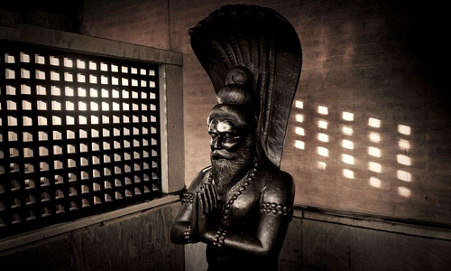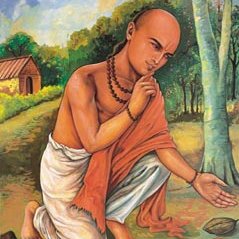
The Great Indian Sages...
Maharshi Patanjali (??) - Known as the father of modern yoga, Patanjali did not really invent yoga. Yoga was already there in various forms.
Maharshi Patanjali assimilated all aspects of Yoga together and gave the world the very famous 'Yoga Sutras'
Maharshi Patanjali (??) - Known as the father of modern yoga, Patanjali did not really invent yoga. Yoga was already there in various forms.
Maharshi Patanjali assimilated all aspects of Yoga together and gave the world the very famous 'Yoga Sutras'

The history of Yoga can be traced from Vedic scripture to the modern period, throughout which it underwent successive refinements.
However, Yoga as a discipline was detailed first by Patanjali in his Yoga Sutras, the first systematized treatise on Yogic theory and practice.
However, Yoga as a discipline was detailed first by Patanjali in his Yoga Sutras, the first systematized treatise on Yogic theory and practice.
Contrary to the modern understanding of Yoga as a form of physical exercise, the Vedic/Hindu concept of yoga is much deeper involving mind, body, and soul.
In a similar line, in the yoga sutra Patanjali talks about not just the practice of yoga but about life and beyond.
In a similar line, in the yoga sutra Patanjali talks about not just the practice of yoga but about life and beyond.
He classified Ashtanga Yoga which consists of eight limbs to achieve nirvana:
1. Yama (vows)
2. Niyama (practices)
3. Asana
4. Pranayama
5. Pratyahara (withdrawal from senses)
6. Dharna (concentration)
7. Dhyana (meditation)
8. Samadhi (the Transcendental State)
1. Yama (vows)
2. Niyama (practices)
3. Asana
4. Pranayama
5. Pratyahara (withdrawal from senses)
6. Dharna (concentration)
7. Dhyana (meditation)
8. Samadhi (the Transcendental State)
Yoga Sutras are divided in to four chapters:
1. Samadhi Pada – 51 Sutras.
2. Sadhana Pada – 55 Sutras.
3. Vibhuti Pada – 56 Sutras.
4. Kaivalya Pada – 34 Sutras.
1. Samadhi Pada – 51 Sutras.
2. Sadhana Pada – 55 Sutras.
3. Vibhuti Pada – 56 Sutras.
4. Kaivalya Pada – 34 Sutras.
The very first shloka on the practice of yoga..
अथ योगानुशासनम् ॥१॥
Now is the discipline of Yoga or this very moment (atha) is your chance to immerse yourself in the state of yoga (yoga)
अथ योगानुशासनम् ॥१॥
Now is the discipline of Yoga or this very moment (atha) is your chance to immerse yourself in the state of yoga (yoga)
He also talked about philosophy of life, law of karma, etc. in yoga sutras.
Apart from that, Maharshi Patanjali also gave commentary on selected rules of Sanskrit grammar from Pāṇini's treatise.
He was a music lover and could play various musical instruments as well.
Apart from that, Maharshi Patanjali also gave commentary on selected rules of Sanskrit grammar from Pāṇini's treatise.
He was a music lover and could play various musical instruments as well.
The breadth of his understanding of life is so big that you cannot believe that this is possible in one human being.
In his mastery of language, mathematics, and in his perception of astronomy, he was fantastic.
In his mastery of language, mathematics, and in his perception of astronomy, he was fantastic.
Maharshi is symbolically depicted in half-man, a half-snake form indicating that he had risen above the duality of life & attained ultimate oneness (In the yogic system, the snake is used as a symbolism for unmanifest energy or kundalini)
I bow down to the great sage of India 🙏
I bow down to the great sage of India 🙏
• • •
Missing some Tweet in this thread? You can try to
force a refresh





